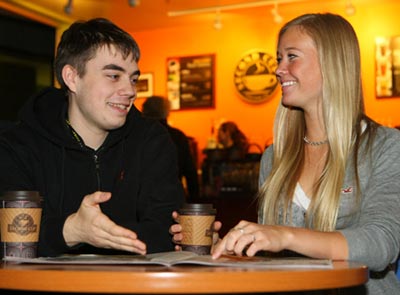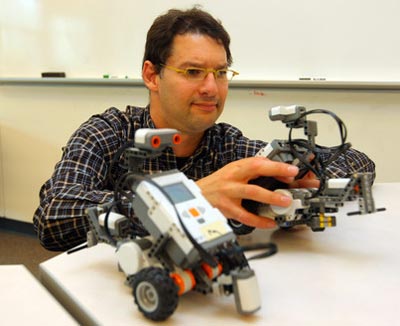Look for an invite in your email
If you get a notice about NSSE, it‚Äôs not in reference to the prehistoric monster who inhabits a lake in the Scottish highlands. Rather, it‚Äôs a chance to improve your school. NSSE (pronounced ‚ÄúNessie‚ÄĚ) stands for the National Survey of Student Engagement. Conducted every three years, NSSE is a benchmark survey that measures students‚Äô levels of engagement with their institution. ‚ÄúThe student voice matters at AVĺ„ņ÷≤Ņ, so I urge you please to take a few minutes and complete the survey,‚ÄĚ says AVĺ„ņ÷≤Ņ President Tom Traves. ‚ÄúWe look at the results very closely in terms of developing programs and services to enhance the student experience at AVĺ„ņ÷≤Ņ.‚ÄĚ A random selection of undergraduate students in their first and senior years can expect an email invitation to participate in NSSE on Monday, January 24. They‚Äôll receive three reminders to respond during the three weeks the survey is open. Survey questions will probe five areas of university life: active and collaborative learning; level of academic challenge; student-faculty interaction; enriching education experiences; and supportive campus environment. ‚ÄúStudents are bombarded with surveys and we understand that,‚ÄĚ says Elizabeth Lane, director of Institutional Analysis and Research at AVĺ„ņ÷≤Ņ. ‚ÄúBut NSSE is important to AVĺ„ņ÷≤Ņ. We developed and implemented programs as a direct result of what students had to say in the last survey (in 2008). ‚ÄĚ Survey results allow us ‚Äú... to see how AVĺ„ņ÷≤Ņ does in relation to our peers in the G-13 as well as the best performers,‚ÄĚ says Ms. Lane. G-13 refers to ‚ÄúGroup of 13,‚ÄĚ the leading, research-intensive universities in Canada to which AVĺ„ņ÷≤Ņ belongs. More than 1,300 different colleges and universities in the U.S. and Canada have participated in NSSE since it was first administered in 2000. |
Initiatives spring out of student feedback
Őż
 |
| Maximilian Werner and Tatiana Hermans became friends through the Peer Partnership Program. (Nick Pearce Photo) |
When Maximilian Werner arrived at AVĺ„ņ÷≤Ņ from Germany, he had ‚Äúa million dumb questions.‚ÄĚ Who should he approach to ask for advice in choosing courses? How do you make friends? Where‚Äôs the best place to go dancing?
Paired with a senior student through the Peer Partnership Program, he soon learned that there were no dumb questions. His mentor, Courtney Larkin, would answer each inquiry patiently, remembering all too well the bewilderment she felt when she arrived at AVĺ„ņ÷≤Ņ.
‚ÄúHer friendship means so much,‚ÄĚ he says, now in the second year of the Bachelor of Management program. ‚ÄúThe North American university system is drastically different and I had no idea how anything worked. So she showed me the ropes. It was just invaluable.‚ÄĚ
A year later, Mr. Werner decided to return the favor by getting involved as a mentor himself in the Peer Partnership Program. The program, which connects first-year students with an upper-level student from their faculty to help ease the transition to university life, is one of the initiatives born out of the 2008 NSSE survey.
Student feedback continues to shape the program, now in its second cycle. Last year, all first-year students were automatically paired with a peer mentor, but this year, they had to apply. It means students actually interested in the program became involved. Training for the mentors was strengthened and activities that mentors and their partners could attend together as friends were organized.
Need to be more engaged
The Peer Partnership Program is by no means not the only strategy to arise out of the 2008 NSSE Survey, which indicated first-year students needed to be more engaged from the outset if they were to forge a meaningful connection to AVĺ„ņ÷≤Ņ. In fact, a new position was established in the Centre for Learning & Teaching and funds were set aside through the Office of the Vice-President Academic and Provost specifically to nurture and develop high-impact student engagement initiatives.
‚ÄúWe have been losing students in their second year, not because they‚Äôre not good students, but because they had a hard time making that transition to university life. Perhaps they were homesick or didn‚Äôt feel financially secure. So the challenge for us to make them feel that they belong, that they can be successful inside and outside the classroom,‚ÄĚ says Deborah Kiceniuk, who was hired in the new position two years ago to facilitate project development.
As well as getting an overall picture of the university, NSSE provides breakdowns for each faculty, outlining strengths and areas that could be improved. The Faculty of Health Professions, for example, resolved to strengthen the student experience in the community by providing training for preceptors, those professionals who oversee students in internships, volunteer opportunities and clinical placements.
 |
| Professor Alex Brodsky teaches the new first-year class Animated Computing. (Nick Pearce Photo) |
In the Faculty of Computer Science, moreover, the survey highlighted a need for more hands-on, project-driven, first-year classes, which would link the theory of computer science with people’s day-to-day interactions with technology. Two courses, Animated Computing and Social Computing, were introduced in the fall of 2009. As well, labs were added to the core, first-year classes, CSCI 1100 and CSCI 1101.
‚ÄúWith Animated Computing and Social Computing this year, we had to add extra sections,‚ÄĚ says Michael Shepherd, Dean of Computer Science. ‚ÄúWith Computer Science I and II, we saw improved retention in second year. The changes have been good for our students and good for us.‚ÄĚ
Other ideas continue to percolate‚ÄĒideas like a dedicated program to improve the study skills of first year students as they transition from high school and a certificate program to foster leadership skills in undergrads. As well, the Peer Partnership Program is spinning off similar programs tailored to specific audiences, such as international students.
Dr. Kiceniuk stands at the centre of a veritable whirlwind of activity aimed at making AVĺ„ņ÷≤Ņ more welcoming and more attentive to student needs.
‚ÄúWhat has amazed me more than anything is that there is so much goodwill here at AVĺ„ņ÷≤Ņ to create a wonderful place for students to learn,‚ÄĚ she says.
